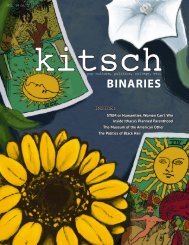Kitsch Magazine: Fall 2015
Binaries
Binaries
- No tags were found...
You also want an ePaper? Increase the reach of your titles
YUMPU automatically turns print PDFs into web optimized ePapers that Google loves.
than just a hairstyle, it was an incredibly powerful symbol of<br />
the civil rights movement.” It is radical in its rejection of the<br />
idea that “‘nappy’ hair [is] unattractive and undesirable” and<br />
that “possessing nappy hair was negative and shameful.” This<br />
article identifies the extent to which wearing your hair in this<br />
“<br />
And as I was realizing this,<br />
certain hairsyles on certain<br />
women began piquing<br />
my interest—women with<br />
long blonde hair, but worn<br />
in dreadlocks; my gut<br />
reaction was a mix of envy,<br />
proprietary anger, and<br />
disdain<br />
”<br />
style was a marker of political affiliation—many women who<br />
had afros did so in imitation of civil rights activist Angela Davis:<br />
“a black person wearing a ‘fro was dubbed as militant and<br />
threatening.” The politicization of black hair was something<br />
you could not escape in the 70s, and as much as wearing a ‘fro<br />
was a symbol of participating in the movement, not wearing<br />
one was by default not participating.<br />
The political nature of black hair didn’t leave us in<br />
the 70s. In the same article, Edwards later comments that the<br />
movement towards natural hair in our own time, a period of<br />
renewed interest in the need for social change around race<br />
issues in America, is parallel to the natural hair movement<br />
of the 1970s. In a similar (though perhaps less intense) way,<br />
wearing your hair natural today makes a statement that you<br />
believe that aesthetic to have as much, if not more worth<br />
than the “European standards,” and carry a subtle but implicit<br />
rejection of those standards. With her light condemning of<br />
“abrasive methods” to “alter who [she] was naturally” and hope<br />
that “it’s not just a style” for her readers, she clearly points to<br />
the unavoidable political affiliations that black women make<br />
with their hair.<br />
This brings us back to the present, to a younger me<br />
thrust into the realization that in America (the magnified<br />
and intensified college-campus version), the way I wear my<br />
hair carries a very particular and very heavy weight. The ten<br />
cornrows my mother learned how to plait across my head are<br />
from a centuries-old African tradition that used to express<br />
kinship, status, religion—a tradition that then moved through<br />
American history, picking up traces of devaluation, critique,<br />
and eventually empowerment. My relaxed hair wasn’t just<br />
something I decided to do when I was 12, it was me participating<br />
in one of the first industries led by and for a marginalized and<br />
excluded social group.<br />
In my new collegiate context I started to work through<br />
all of this new information. I had to come to terms with the<br />
history of women of color in America. I had to learn what new<br />
codes applied to me now that I occupied a new social space. I<br />
realized that I could no longer be blissfully ignorant of the fact<br />
that even if I do my hair based on a whim, it will always carry<br />
the history of people with hair like mine.<br />
And as I was realizing this, certain hairstyles on certain<br />
women began piquing my interest—women with long blonde<br />
hair, but worn in dreadlocks; women braiding thin cornrows<br />
into their straight dark hair, fixing them with beads. Every time<br />
I saw them, my gut reaction was a mix of envy, proprietary<br />
anger, and disdain. At first I tried to quash my negative kneejerk<br />
response to these hairstyles, telling myself that judging<br />
other women for their hair choices was participating in the<br />
practice that I fell victim to. Maybe they weren’t thoughtlessly<br />
following what they assumed was a fad, or callously assuming<br />
wearing their hair that way gave them cultural capital. Perhaps<br />
they know more about the importance of the hairstyle than I;<br />
who am I to judge a prominent scholar or devout Rastafarian<br />
based only on the color of their skin or texture of their hair?<br />
But try as I might I couldn’t wrangle the anger into a generous<br />
benefit of the doubt.<br />
I existed in this limbo for ages, feeling anxious about<br />
how my hair was perceived, about how it was and wasn’t<br />
what I wanted it to be, and anxious about what I thought<br />
was irrational anger. I spent my time resenting that anxiety,<br />
and searching for a way to tame my mane while in Ithaca<br />
(my daunting experience of trying to find a place to get my<br />
hair done as a freshmen in this town is a story for another<br />
time). And then I started hearing grumbles from corners of the<br />
Internet that I stumbled upon during my hair research. I read<br />
about Bo Derek, a white actress, who is famed for popularizing<br />
cornrows in 1979 when Cicely Tyson had been wearing them<br />
on screen in the early 70s. I read about how Madonna wore an<br />
afro in the 90s as one of her many “out there” looks, and how<br />
Lady Gaga did the same with dreadlocks in 2013. I read about<br />
magazines like Elle and Marie Claire touting Gwen Stefani and<br />
Katy Perry as trendsetters of styles like bantu knots and babyhairs<br />
which had been black hairstyles without fanfare for ages.<br />
25




